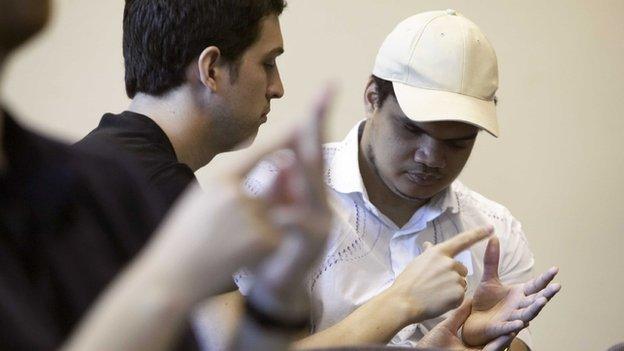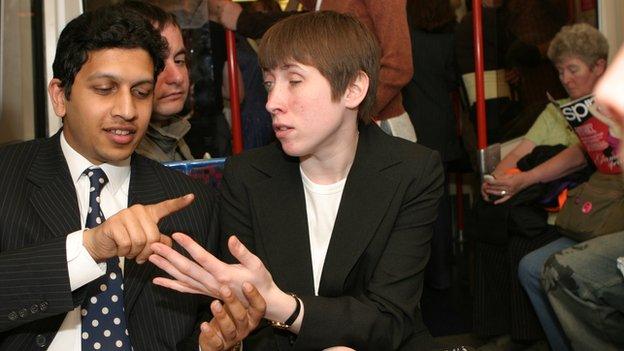Lesser-known things about being deafblind
- Published

For Liz Ball, who no longer has hearing or sight, communication happens mainly through touching other people's hands. Here she reveals five lesser-known things about being deafblind.
The word on the breeze, and through the floor
Deafblind people aren't affected by things that many would consider a distraction. This means they can work through lively conversations, office tea parties, loud music, thunderstorms and the like.
But, create the tiniest of drafts by picking up a sheet of paper, or the smallest of vibrations by placing a foot gently on the floor, and this might instantly attract the attention of a deafblind person.
There are other kinds of distractions. I've declared one meeting venue unusable because its wooden floor amplifies vibrations from the fridge in the adjacent kitchen. The hearing people with me were unaware of the vibration until I drew it to their attention, but I found it intolerable.
You are what your hands say you are
There are many different forms of touch, or tactile, communication. Deafblind manual is a form of tactile fingerspelling, where each letter of the alphabet has a sign that is made against your hand. There's hands-on signing, where a deafblind person puts their hands over the hands of the person they are communicating with to feel the shapes and movements of British Sign Language. Some may use the block alphabet where large capital letters are drawn with a finger onto the palm.
The way a person touches can say a lot about them. From stiffness in the hands, to firmness and rhythm, or tactile language ability, snap judgements can be made about someone's personality or motives just as they can be with a look or a tone of voice.
Deafblind people might not see what others look like, or what they are wearing, but first impressions still count, and these get transmitted by hands.

Tense hands and awkward movements? Neurotic. Firm yet relaxed hands with a steady rhythm? Conscientious and open.
Like all ways of forming first impressions, it can be wrong, but who can stop themselves?
Talking while you eat
If you communicate by touch alone, it can be difficult to chat with friends over dinner. It involves stretching arms and contorting in order to communicate across the table while trying not to knock over drinks and other such messy hazards.
In a recent blog entry, deafblind poet and essayist John Lee Clark, external suggests putting people in the middle of the room and the table around the outside. I've seen people communicating with each other like this at events and it looks like a good way to make socialising at mealtimes more accessible.
There are more ways to communicate with deafblind people than there are deafblind people
Communication can happen in lots of different ways - clear speech, tactile fingerspelling, signing made more easy to see or feel, and so on. But, to complicate things further, deafblind people evolve their own variations on these methods.
I communicate using deafblind manual but use five different ways of communicating numbers, depending on who I am speaking with and what they know.
Some people might dot Braille numbers on the back of my hand or draw print numbers on my palm. Or those more familiar with BSL might adapt it. For example one is gripping my index finger, two is index plus middle, three is index plus middle plus ring.

Deafblind people might carry information when going out to instruct people on how to communicate with them
Touch to talk
If a deafblind person is touched, they assume someone wishes to communicate with them as they cannot see or hear them.
When someone touches me I try and guess their intention. For example, if I am sitting on a train I assume it's the ticket inspector, and hold my ticket out.
I can speak and am able to explain how the person can communicate with me. I offer my Braille and print deafblind manual card so they can spell out words to me on my hands. But I may be speaking to thin air or to someone who touched me accidentally. Ironically, it can then take ages for them to explain on my card that they don't actually want to talk.
To get my attention, tap my shoulder, arm or hand. Stand close if you want to communicate but step back if you don't - I communicate very closely with people but also like a bit of personal space.
My colleagues and I invented a secret Morse code signal to use with me if they see me travelling alone and looking stressed or ignoring normal taps. We invented it after an incident at a London railway station where I was waiting for a colleague one morning. Staff and passengers were grabbing at me and not listening to a word I said about communicating with my card. I ended up getting very upset.
When my colleague arrived, she tapped me but I spoke out loud to tell whoever it was to leave me alone. So we invented the secret Morse signal as a quick way for colleagues to say "it's ok, I know what I'm doing, I can communicate with you".
Though I've been concentrating on touch communication on this page, it's worth noting that many people who call themselves deafblind can see and/or hear a little.
Liz Ball works for SENSE the deafblind charity, external where she is Campaigns Involvement Officer. She has been blind from birth but also became deaf at 26.
Follow @BBCOuch, external on Twitter and on Facebook, external, and listen to our monthly talk show